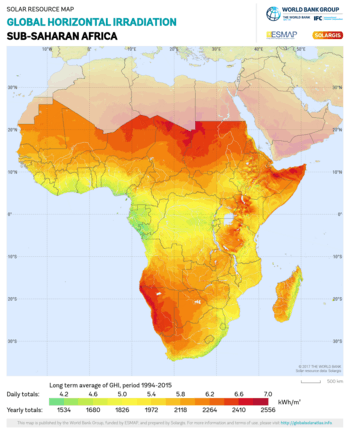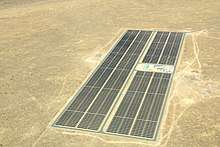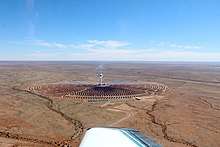Solar power in Africa
Africa is often considered and referred as the "Sun continent" or the continent where the Sun's influence is the greatest.[2] According to the "World Sunshine Map", Africa receives many more hours of bright sunshine during the course of the year than any other continent of the Earth:[3] many of the sunniest places on the planet lie there.[4]


Despite the large solar potential, penetration of solar power in Africa's energy sector is still very low.[5]
Solar potential
The whole continent has a long duration of sunshine, and excluding the large areas of tropical rainforests (the Guinean Forests of West Africa and much of the Congo Basin), since desert and savannah regions of Africa stand up as Earth's largest cloud-free area.[6] Africa is dominated by clear skies even beyond deserts (ex : Sahara, Namib, Kalahari),[7] however, the regions located along the equator are considerably cloudier than the tropics and subtropics.
The eastern Sahara/northeastern Africa is particularly noted for its world sunshine records. The area experiences some of the greatest mean annual duration of bright sunshine,[8] as the sun shines bright during approximatively as much as 4,300 hours a year,[9] which is equal to 97% of the possible total.[10] This region also has the highest mean annual values of solar radiation[11][12] (the maximum recorded being over 220 kcal/cm2[13]).
The low latitude of the landmass is another asset: much of the continent lies in the intertropical zone, where the intensity and the strength of the sunlight are always high. The area contains lots of vast sun-drenched arid and semi-arid expanses in the north, in the south, and to a lesser extent in the east. About two fifths of the continent are desert, and thus continuously sunny.
The combination of all these geographical and climatic factors is the cause of the large solar potential of Africa. The number of days of sunlight allows the potential of bringing solar power to much of Africa without large scale grid infrastructure.[14]
The distribution of solar resources across Africa is fairly uniform, with more than 85% of the continent's landscape receiving a global solar horizontal irradiation at or over 2,000 kWh/(m2 year).[15][16][17] Also, the theoretical reserves of Africa's solar energy are estimated at 60,000,000 TWh/year, which accounts for almost 40% of the global total, thus definitely making Africa the most sun-rich continent in the world.[18]
Solar photovoltaics

Declining solar equipment costs are expected to significantly increase solar installations in Africa with an industry projection forecasting that the continent's annual PV market will expand to 2.2 GW by 2018.[19] Future installations for harvesting solar energy in Africa will tend not to be found within the equatorial and subequatorial climate zones, that are located in the western part of Central Africa usually near the equator but that extend as far north and south as the 8th or 9th parallel in both hemispheres, since they are systematically linked with almost permanent cloud cover and only intermittent bright sunshine. Therefore, countries that entirely lie in this wet-humid zone such as the Republic of the Congo, Equatorial Guinea, Gabon, Rwanda, Uganda, Burundi, Liberia and Sierra Leone are by far the least favoured in solar power of all the continent and except for these eight quoted nations, each other African country experiences over 2,700 hours of bright sunshine on at least a part of its territory. Many perpetually sunny African nations like Egypt, Libya, Algeria, Niger, Sudan, South Africa and Namibia for instance could rely on developing their tremendous solar resources on a large scale thanks to the immense surface of their territory and at reduced prices.
South Africa is a leader in solar power in Africa with 1329 MW installed by 2016.[20] Solar power in South Africa is rapidly growing. Several 75 MW PV plants and 2 CSP plants at 100 MW each were the largest in the country and among the largest in Africa. South Africa has announced a plan to install a minigrid on Robben Island; adding PV and battery storage is predicted by reduce diesel usage by half.[21]
A 50 MW photovoltaic power plant is planned for Garissa in Kenya, a city located at the equator where the sun is said to shine for about 3,144 hours each year on average, and it is expected to produce approximately 76,473 MWh/year.[22]
A 155 MW photovoltaic power plant is planned for Ghana and the government plans to increase solar power in the country from 22.5MW in 2017 to 300MW in 2020.[23][24]
There are also many small-scale modular solar power installations being implemented across the continent at the village and household levels.[25] In 2015, Sub-Saharan Africa was the leading region for purchases of off-grid solar products.[26]
| Year | Photovoltaics | CSP | |
|---|---|---|---|
| MWp | MWp | ||
| 2010 | 40[27] | 20 | |
| 2011 | 41[27] | 65 | |
| 2012 | 65 | ||
| 2013 | 65 | ||
| 2014 | >922[28] | 68 | |
| 2015 | 1,420[29] | 218 | |
| 2016 | 428 | ||
Solar thermal power

Focusing light above the tower
The Kingdom of Morocco’s solar plan, which is one of the world’s largest solar energy projects and estimated to cost about $9 billion, was introduced in November 2009 with the aim of establishing 2,000 MW of solar power by 2020. Five sites have been selected for the development of solar power plants combining a number of technologies including concentrated solar power, parabolic trough as well as photovoltaics, with the 500MW phase one solar power complex at Ouarzazate being the first to be developed.[30][31][32] The first part of the 500MW project, the 160MW Noor I came online in 2016 and uses parabolic trough concentrated solar power technology.[33] Morocco, the only African country to have a power cable link to Europe, aims to benefit from energy sales to Europe. One such initiative was Desertec.[34]
South Africa has developed several solar thermal plants, both parabolic trough and power tower types. In 2017, it was the leading country in Africa for both solar thermal and PV solar energy.
See also
- Solar power in Algeria
- Solar power in Morocco
- Solar power in South Africa
- Renewable energy in Africa
- Solar power by country
References
- "Global Solar Atlas". Retrieved 6 December 2018.
- Griffiths, I.L. (2013). The Atlas of African Affairs. Taylor & Francis. p. 15. ISBN 9781135855529. Retrieved 2017-01-29.
- Powell, R.; Bowden, D.; Tresemer, D.; Bento, W.; Farrants, W.; Gray, B.; Dann, K.; Paul, L.; Lainson, C.M.L.; Nurney, S. (2012). Journal for Star Wisdom 2013. Lindisfarne Books. ISBN 9781584201366. Retrieved 2017-01-29.
- "Sunniest Places and Countries in the World - Current Results". currentresults.com. Retrieved 2017-01-29.
- "A Snapshot of Global PV (1992-2015)" (PDF). IEA. Retrieved 2016-12-05.
- Daniels, S.; Lee, R. (2014). Exploring Human Geography: A Reader. Taylor & Francis. p. 425. ISBN 9781317859222. Retrieved 2017-01-29.
- "News - Thirteen years of cloud cover, in one beautiful map - The Weather Network". theweathernetwork.com. Retrieved 2017-01-29.
- Holford, Ingrid (July 1, 1977). The Guinness Book of Weather Facts and Feats. Guinness Superlatives. ISBN 9780900424755 – via Internet Archive.
sahara.
- Dunlop, S. (2008). A Dictionary of Weather. OUP Oxford. ISBN 9780191580055. Retrieved 2017-01-29.
- Holford, Ingrid (July 1, 1977). The Guinness Book of Weather Facts and Feats. Guinness Superlatives. ISBN 9780900424755 – via Internet Archive.
4300.
- Riordan, P.; Paul G. Bourget; U.S. Army Engineer Topographic Laboratories (1985). World Weather Extremes. The Laboratories. p. 66. ISBN 9780788115370. Retrieved 2017-01-29.
- Climate and Life. Elsevier Science. 1974. p. 151. ISBN 9780080954530. Retrieved 2017-01-29.
- Wadsworth, F.H.; United States. Forest Service (1997). Forest Production for Tropical America. U.S. Department of Agriculture, Forest Service. Retrieved 2017-01-29.
- Othieno, Herick (16 October 2015). Energy resources in Africa : distribution, opportunities and challenges. Awange, Joseph L., 1969-. Cham. p. 19. ISBN 978-3-319-25187-5. OCLC 925521900.
- German Aerospace Center, Institute of Technical Thermodynamics, Section Systems Analysis and Technology Assessment (April 2005), Concentrating Solar Power for the Mediterranean Region (PDF)CS1 maint: multiple names: authors list (link)
- "Free, clean solar energy year-round". bosmos.com. Retrieved 2017-01-29.
- Solar Radiation Maps: Global Horizontal Irradiation (GHI), Solar GIS
- Liu, Z. (2015). Global Energy Interconnection. Elsevier Science. p. 30. ISBN 9780128044063. Retrieved 2017-01-29.
- "Middle East and Africa Solar PV Demand to Grow by 50 Percent in 2014, According to NPD Solarbuzz". NPD Group. 2014-04-24. Retrieved 2014-08-19.
- "Monitoring of Renewable Energy Performance 2016". www.nersa.org.za. Retrieved 2017-06-03.
- South Africa’s Robben Island to be solar powered, Decentralized Power, Diarmaid Williams, 23/10/2017
- "Chinese firms to build solar power plant in Garissa". the-star.co.ke. Retrieved 2017-01-29.
- "Ghana solar energy plant set to be Africa's largest - BBC News". bbc.co.uk. Retrieved 2017-01-29.
- Government targets 300MW of solar by 2020, GhanaWeb, 25 September 2017
- Kemeny, P; Munro, P G; Schiavone, N; van der Horst, G; Willans, S (2014). "Community Charging Stations in rural sub-Saharan Africa: Commercial success, positive externalities, and growing supply chains". Energy for Sustainable Development. 23: 228–236. doi:10.1016/j.esd.2014.09.005.
- Renewables 2016 Global Status Report, REN 21, p. 91
- "Global Market Outlook for Photovoltaics until 2016". Archived from the original (PDF) on November 6, 2014.
- "Snapshot of Global PV Markets 2014" (PDF). IEA PVPS. Retrieved 25 October 2017.
- "SNAPSHOT OF GLOBAL PHOTOVOLTAIC MARKETS 2015" (PDF). IEA PVPS. Retrieved 25 October 2017.
- "masen.org.ma/index.php?Id=42&lang=en#/_". masen.org.ma. Archived from the original on 2016-03-14. Retrieved 2017-01-29.
- "ecogeek.org/component/content/article/3770". ecogeek.org. Archived from the original on 2014-09-24. Retrieved 2017-01-29.
- "IEA - 404 Not Found". iea.org. Retrieved 2017-01-29.
- Reuters Editorial. "Morocco says investors lining up for $9 bln solar project | Reuters". uk.reuters.com. Retrieved 2017-01-29.
- "Morocco Solar | Solar GCC". solargcc.com. Retrieved 2017-01-29.